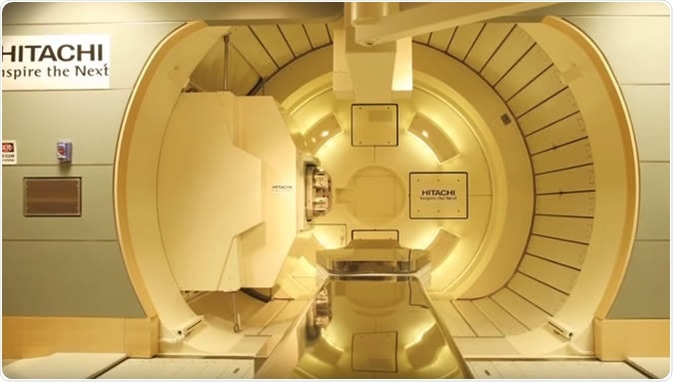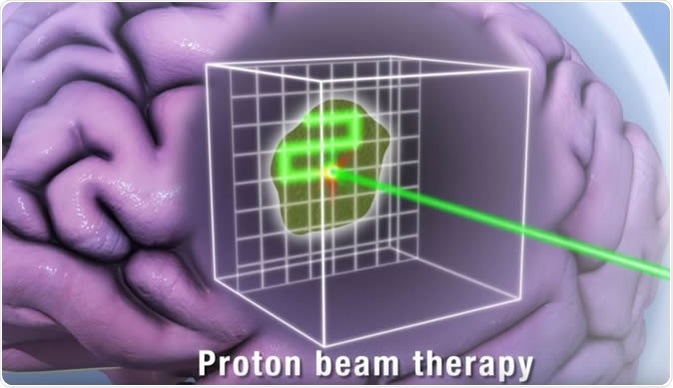What is Proton Therapy?
Skip to:
- Before therapy
- How does Proton Therapy work?
- Benefits and side effects
- Previous research on Proton Therapy

Proton Beam Therapy machine - Credit: Mayo Clinic
A proton is a positively charged subatomic particle. Protons are used within Proton Therapy, also known as Proton Beam Therapy, which is a treatment for cancer.
At high energy, the protons can kill cancer cells. Examples of diseases that are targeted are; prostate cancer, brain cancers, and tumors.
Rather than using X-rays, proton therapy utilizes high energy protons and can successfully target a tumor, leaving the surrounding healthy area less affected than with traditional radiation therapy.
Research has shown that at high energy, protons can destroy cancer cells. In many ways, this new and improved research has noticed fewer undesirable side effects in which other cancer treatments have encountered.
Before therapy
Before considering any therapy, it is necessary to do lots of planning to ensure proton therapy is right for the patient. Imaging studies, such as computed tomography (CT) and magnetic resonance imaging (MRI), are used to mark clearly where the tumors are on the body.
CT and MRI scans are carried out prior to proton therapy treatment to determine the exact positioning for the radiation and accurate placement of each treatment. The patient is placed into a machine on the treatment table; X-Rays or CT scans are taken, and positioning information is programmed into a computer to ensure the patient is in the same position for every treatment.
How does Proton Therapy work?
Once the patient is positioned correctly, the treatment can begin. The health care professionals will leave the room and control the machine from outside the room. The proton treatment is then delivered from the control room and the health care professionals can see and hear the patient inside the treatment room. Treatment begins by the protons traveling through the machine and the magnets directly to the tumor.
An invisible beam is targeted to the tumorous area. At pencil-point precision, the radiation is released and allows protons to interact with electrons allowing a release of high energy. The high energy is then released into its designated location, the tumor.

Image Credit: Mayo Clinic
The treatment generally will last around 15 to 30 minutes, depending on the part of the body being treated and the number of treatments needed. However, this time varies from patient to patient.
Benefits and side effects
There are many benefits of proton beam therapy, which can be compared to X-ray radiation therapy. As Proton Therapy targets the tumor, there is 60% less radiation on the surrounding healthy tissue. The treatment allows high levels of radiation to reach the tumor and covering the entire tumor to be destroyed.
A study of men with localized prostate cancer showed that proton therapy was associated with a disease-free survival rate of 89%.. More patients are free of disease as those cited in published results of other radiation treatments. Proton therapy has noticed fewer side effects in comparison to other treatments.
Although the proton beam therapy itself is painless, there are side effects that have been researched, including fatigue, redness, irritation, swelling, and peeling of the targeted area. However, there are fewer side effects in comparison to other radiation treatments. Proton therapy sees higher energy levels contributing to lower fatigue, and overall the patient is in less pain after treatment.
Previous research on Proton Therapy
The study conducted by the University of Michigan in 2019, observed fewer emergency hospitalizations in the proton therapy control group. This suggests that proton therapy is more beneficial to patients and health services as well as adding to the quality of life of both patients and their caregivers.
Penn Medicine studied a group of around 1,500 patients, reviewing several cancers. Their study looked at tumors and how they spread around the body after proton therapy, compared with x-ray radiation therapy.
There was no significance between the patients undergoing proton therapy and x-ray radiation in survival and cancer control. The survival rate of proton therapy 83%, and 81% for x-ray radiation, proton therapy is as effective as other therapies and fewer side effects.
Although there has been vigorous research and five years of study on proton beam therapy, it is still only available in a few medical centers across the US. As the treatment is intricate and targets specific areas, it could cost more than x-ray radiation therapy. With the typical pricing of $150 million US Dollars on average for each machine, it can prove costly in comparison to alternative types of radiation therapy.
Sources
- Proton Therapy- Treatment for Tumors. Available at: www.radiologyinfo.org/.../info.cfm
- Proton Therapy- Department of Radiation Oncology: Emory University School of Medicine (2020). Available at: radiationoncology.emory.edu/patients/treatments/proton-therapy.html
- Proton Radiation Therapy for the Treatment- Mouw, et al, 2014, “Radiation Therapy for the Treatment of Retinoblastoma”, International journal of Radiation Oncology. Pp- 863-869. www.cancer.ca/.../?region=qc
- WHO: When subatomic physics research meets clinical oncology 2020. Available at: https://www.who.int/bulletin/volumes/90/7/12-030712/en/
- Merchant, T. (2009) “Proton Beam Therapy in Pediatric Oncology”, The cancer Journal. doi: 10.1097/ppo.0b013e3181b6d4b7. https://insights.ovid.com/pubmed?pmid=19672146
- Fuji, H. et al. (2013) “Assessment of Organ dose reduction and secondary cancer risk associated with the use of proton beam therapy and intensity modulated radiation therapy in treatment of neuroblastomas”, Radiation Oncology. https://ro-journal.biomedcentral.com/articles/10.1186/1748-717X-8-255
- Proton therapy as effective as standard radiation with fewer side effects: Washington University School of medicine in St. Louis (2019) Available at: medicine.wustl.edu/.../proton-therapy-as-effective-as-standard-radiation-with-fewer-side-effects
Further Reading
Last Updated: Feb 13, 2020
.jpeg)






















.png)









No hay comentarios:
Publicar un comentario